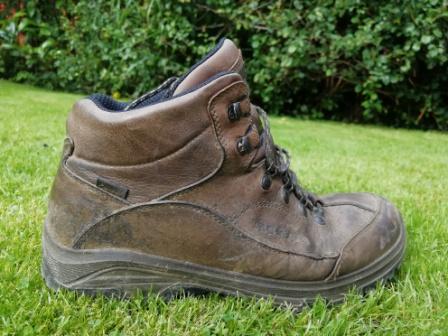Introduction
I like to visit Coombes Valley RSPB reserve just south of Leek every spring, always hoping to see its speciality bird, the pied flycatcher.
This year, I chose to combine my trip with a longer walk in this lovely Staffordshire countryside.
Travel time –50 minutes each way. Walk time – 3.5 hours plus a quarter of an hour for lunch and half an hour birdwatching.
The weather was cold (5 – 7 deg C) but mostly sunny with little wind, so quite pleasant for walking. There was just one squally sleet shower that was quite short-lived.
The walk was 7.6 miles, and fairly easy going.
Much of the walk was on farmland or in a bird reserve, so not really suitable for dogs to be running free.
OS Explorer Map OL24.
I parked for free on the roadside, next to a telegraph pole, at the start point for the walk. The walk could be adjusted to take in the RSPB Visitor Centre where there is parking and toilets.

Cheddleton Heath
I set out along the track to Yew Tree Farm, and soon, on a farm shed, saw this sign which I hoped was not a sign of things to come.

On my left there were far reaching views to the north. The mound of Shutlingsloe is visible on the skyline towards the right of the picture.

After the farm, a right turn took me through my first horse field of the day. Then there were a couple of loud, but harmless dogs roaming free at Crowhalt.
Coombes Valley RSPB Reserve
After crossing the road and a copse, a stile took me into the reserve, a place I first visited with my parents (who were RSPB stalwarts) in the late 1980s. However, I’d not seen one of these before!
Some research seems to indicate it to be a mouflon, a subspecies and a feral descendant of domestic sheep. It was originally found only on the Mediterranean islands of Corsica and Sardinia, so what it was doing here, I cannot say!
As I proceeded down the valley, I was shocked to be reminded again of the devastating effect ash dieback disease is having in this part of the world. I’m currently reading the novel “The Overstory” by Richard Powell, which focuses on the primacy of trees in the world, so to see the decimation of these trees is additionally distressing.

Arriving at the bottom of the valley, I’m surprised to still be alone. I stop to sit at the pond where I have seen that elusive bird on a previous visit. A busy robin continually grabbed my attention away from the surrounding treetops where there is little movement. However, patience is a virtue, and after about 10 – 15 minutes, he appeared, about 30 yards away. It’s a small bird, but unmistakable with its pure white breast, black head and back and white wing bar. This library picture was taken by a proper photographer, at Coombes Valley in 2014.

Here’s another library picture, slightly closer up.

An intrepid lady photographer, and a couple more birders arrived, so I pointed out the bird, and moved on, very satisfied.
Sharpcliffe
It sounds like a Jane Austen novel, and well… here’s Sharpcliffe Hall, complete with Rolls Royce!

There are great views along the drive, but as I looked back to the north it seemed the storms could be closing in.
I headed south over farmland, towards Stocks Green, and just over a stream found a sheltered spot to stop for lunch, with blackcaps, willow warblers and a noisy wren providing the soundtrack.

Blackbank Wood
After Stocks Green with its pretty church and adjacent mound, which has a trig point at just 273m high, I went past the cottages at Coltstone, and down a beautiful path through Blackbank Wood. This, and to a slightly lesser extent, the later Whitehough Wood are real hidden treasures, completely off the beaten track.
At Collyhole Farm, I had to move quite nimbly to avoid a confrontation with some young cattle that eyed me suspiciously.
Whitehough Wood
I passed Whitehough Hall , another grand country pile, and arrived at the wood, where rhododendron clearance and freshly planted birches had created space for delightful bluebells. It was here that I encountered a sleet squall, and sheltered under a large tree for a short while.
The path now returned into the RSPB Coombes Valley reserve, heading back down to the narrow bridge at the beautiful Combes Brook (note the different spellings of Co(o)mbes is as per the OS Map).
The Last Stretch
After rising up and out of the valley, the last stretch was over farmland, with some very long, and now very wet, grass. I was pleased I’d worn gaiters. The views remained splendid.

This towering oak tree provided a last contrast with the dead ashes behind it down at the bottom of the valley.

This walk was packed with varied and interesting sights. Highly recommended.
And Finally….
New pop music for 2021 from The Coral! Take Me Back To The Summertime….. yes please!
















You solved problem for us,I think! Have remember Sharpcliffe Hall in my mind but could not work out where it was! Walked round there in 2003 I have a feeling it was empty, even more atmospheric! Could mouflon perhaps have escaped from small zoo not far away on main road south.Not heard much about ash die back recently.Worse bit I’ve seen so far was in Monsal Dale in 2019Most trees in dale wre ash must look worse now
Yes, Monsal Dale is really bad, but the whole area is blighted. Sad.